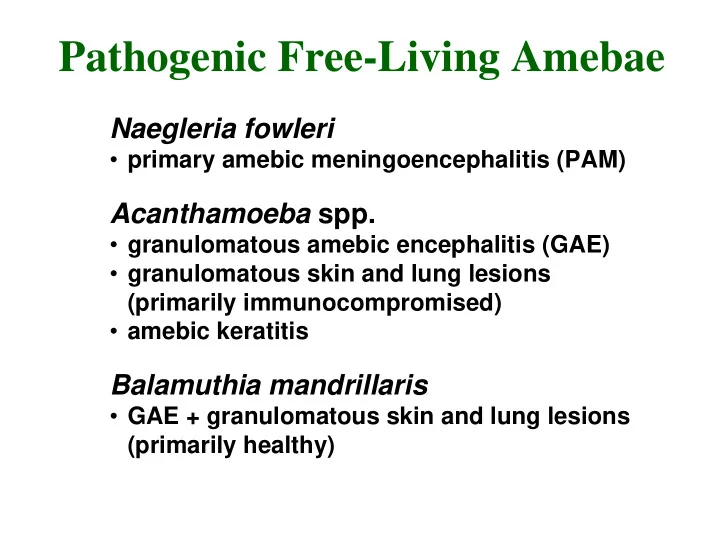

Pathogenic Free-Living Amebae Naegleria fowleri • primary amebic meningoencephalitis (PAM) Acanthamoeba spp. • granulomatous amebic encephalitis (GAE) • granulomatous skin and lung lesions (primarily immunocompromised) • amebic keratitis Balamuthia mandrillaris • GAE + granulomatous skin and lung lesions (primarily healthy)
Naegleria Life Cycle low nutrients feeding and Trophozoite = desiccation replicating form Cyst = dormant form
Naegleria fowleri • ubiquitous genus found in fresh water lakes and ponds • PAM first recognized by Fowler (1965) • initially thought to be Acanthamoeba • Naegleria fowleri is only species associated with PAM • ~ 200 documented cases worldwide • 81 in U.S. • 14 cases from same lake in Virginia • 16 cases from same stream feed pool in Czech Republic
Primary Amebic Meningoencephalitis (PAM) • 1-14 days incubation period • symptoms usually within a few days after swimming in warm still waters • infection believed to be introduced through nasal cavity and olfactory bulbs • symptoms include headache, lethargy, disorientation, coma • rapid clinical course, death in 4-5 days after onset of symptoms • trophozoites can be detected in spinal fluid, but diagnosis is usually at autopsy • 4 known survivors treated with Amphotericin B
in vitro culture brain section “lobopodia”
Acanthamoeba life cycle
Acanthamoeba • ubiqutous ameba of the soil and water • Culbertson (1958) fortuitously produced disease in mice (culture contaminant) • human cases first reported in the early 70's • 73 cases worldwide of GAE as of 1991 • 39 in U.S. • majority of patients are chronically ill, immunocompromised, or debilitated with other diseases • also produces amebic keratitis and skin and lung lesions
Acanthamoeba Meningoencephalitis • portal of entry unknown, possibly respiratory tract, eyes, skin • presumed hematogenous dissemination to the CNS • infection associated with debilitation or immunosuppression • onset is insidious with headache, personality changes, slight fever • progresses to coma and death in weeks to months • amebas not yet detected in spinal fluid • trophozoites and sometimes cysts detectable in histological examination • no human cures documented
Amebic Keratitis • predisposing factors • ocular trauma • contact lens (contaminated cleaning solutions) • symptoms • ocular pain • corneal lesions (refractory to usual treatments) • diagnosis • demonstration of amebas in corneal scrapings • treatment • difficult, limited success • corneal grafts often required
Balamuthia mandrillaris • first report in mandrill baboon (1990) • genus/species named 1993 • morphology similar to Acanthamoeba • many Acanthamoeba GAE cases retrospectively assigned to Balamuthia • as of 1997 63 cases of Balamuthia (30 in U.S.) • thus far only identified post-mortem • environmental source not yet identified
Recavarren-Arce et al (Human Path. 30:269, 1999) • 10 autopsies (1985-97) of Balamuthia cases in Peru • all healthy and all died within days or weeks of neurological symptoms • primary lesions: 8 nasal, 3 dermal • questioned hematogenous dissemination in both Acanthamoeba and Balamuthia • no intravascular ameba (this study and literature) • perivascular infiltration frequently observed • propose perivascular route from primary mucosal lesion
Red Tides • ‘blooms’ of dinoflagellates • phyto- and zooplankton • usually monospecific • rapid population increase • nutrients, lack of grazing, sunlight, etc • long cyst survival in some species Increasing Incidence • better monitoring (seafood, aquaculture) • coastal pollution/nutrients • agricultural wastes/fertilizers • long distance shipping
Potential Impact of Red Tides • deplete oxygen → dead zones • produce toxins → fish kills • accumulated dinoflagellate toxins pass up the food chain • 'Ciguatera' • ‘shellfish’ poisoning Toxic Dinoflagellates and Shellfish Poisoning Dinoflagellate Type of SP Toxin Gymnodinium breve neurotoxic brevetoxin Alexandrium tamerense paralytic saxitoxins Prorocentrum lima diarrhetic okadaic acid Pfiesteria piscicida neurotoxic + ?
Pfiesteria piscicida • effects observed in late 1980’s (named 1996) • fisherman and swimmers complaining of rashes, lesions, respiratory and neurological problems • massive fish kills in east coast estuaries • complex life cycle (at least 24 morphological forms) Human Exposure to Pfiesteria Aerosols • narcosis/disorientation • respiratory distress/asthma-like • stomach cramping/nausea/vomiting • eye irritation/blurred vision • erratic heart beat (weeks) • sudden rages/personality changes • short term memory loss
Pfiesteria Toxins • culture filtrates induce open ulcerative sores, hemorrhaging and death in fish • at least two toxins • heat-stable, water-soluble toxin (fish become moribund within seconds and die within minutes) • lipophilic compound (causes the epidermis to slough off) Why produce toxins? • accidental chemical affinity • self-defense (zooplankton, grazers) • ambush-predator life style
Recommend
More recommend